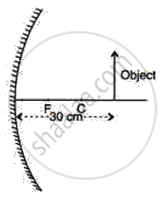Advertisements
Advertisements
Question
An object is placed in front of a concave mirror as shown in the following figure. By scale drawing, find the nature of the image. Given f = 10 cm, v = 30 cm.

Solution
Focal length o f concave mirror= 10 cm. Object distance = 30 cm.

The image is real, inverted, and diminished.
APPEARS IN
RELATED QUESTIONS
Find out the letters of English alphabet or any other language known to you in which the image formed in a plane mirror appears exactly like the letter itself. Discuss your findings.
A 2.0 cm tall object is placed 40 cm from a diverging lens of focal length 15 cm. Find the position and size of the image.
Write true or false
A virtual image formed by a spherical mirror is always erect and situated behind the mirror.
A ray of light travels from a denser medium to a rarer medium. How will it bend?
State the direction of incident ray which after reflection from a spherical mirror gets reflected along its own path. Give a reason.
State the types of mirrors used for (i) headlights and (ii) rear view mirror, in cars and motorcycles. Give to justify your answer in each case.
State the number of images of an object placed between two mirrors, formed in each case when mirrors are inclined to each other at (a) 90°, and (b) 60°.
Name the mirror which always produces an erect and virtual image. How is the size of image related to the size of object?
Why does a driver use a convex mirror instead of a plane mirror as a rear view mirror?
Illustrate your answer with the help of a ray diagram.
A converging lens of focal length f is placed at a distance 0.3 m from an object to produce an image on a screen 0.9 m from the lens. With the object and the screen in the same positions, an image of the object could also be produced on the screen by placing a converging lens of focal length.
